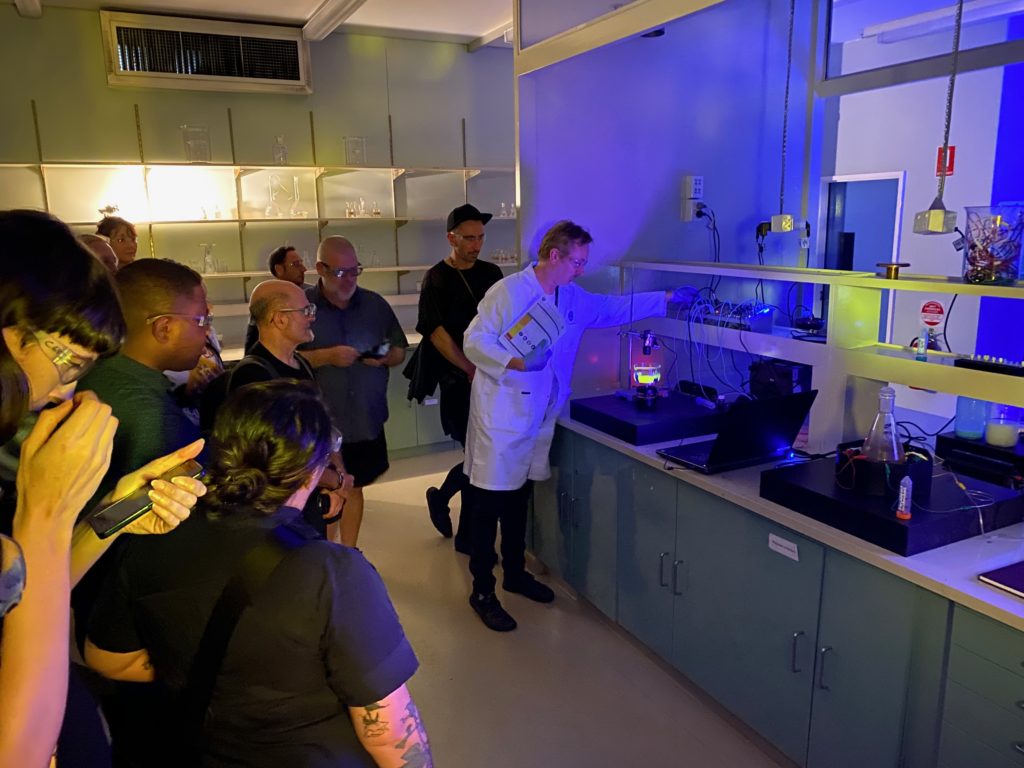
How does one get to the heart of the MOF? How can one converse with the MOFverse? That’s the burning question! Credit: ANAT
Deep in our Clayton site lies an unusual raft of bubbling chemicals, waiting to be observed. But you must search for it. It takes flights of stairs, a labyrinth of hallways, weaving in and out of labs, safety glasses and a lab coat to access this elusive reaction.
But here we have played host to our very own art installation – Synthesism. A heady mix of metal organic frameworks (or MOFs, a subset of chemistry) and artistic vision, Synthesism plays on light and chemical reactions to create something visually stunning. This strange exhibit has taken a year of experiments and discovery to create. Artist Chris Henschke commissioned it during his recent residency here.
So how did something so reminiscent of Dark Mofo end up at one of our labs?
A next-generation material
MOFs are a new class of programmable molecules with unique and complex surface structures. They’re made of metal atoms joined to each other by organic linker molecules. These form points (nodes) that bind the arms of the linkers together. This creaties a repeated, hollow cage-like structure with a huge internal surface area.
Think of a sponge, filled with tiny holes that can absorb, store and release many times its surface area in liquid. In the same way, MOFs can diffuse gas and liquid molecules in and out of their pores without any changes to their structure. And depending on their design, they will absorb or not absorb particular molecules, making them an ideal candidate for use in filters.
Get this – it takes only one teaspoon of the sponge-like MOF crystals to absorb the entire surface area of the MCG!
At last count, there were 69,666 MOFs. Each is designed with different applications and chemical interactions in mind. Some store, deliver or filter different types of gases and liquids. Others can purify water.
The science behind MOFs is evolving quickly. But up until recently, no one had thought to explore the philosophical intentions of a MOF. Until Chris – an experimental digital media artist – asked a few burning questions about these structures.

Chris Henschke, artist in residence, outlining how each of his MOF art pieces works. Credit: ANAT
A chemical reaction to behold
Chris worked with our MOF researchers, through an ANAT Synapse residency. His experiments focused on the nature of chemical synthesis, and how this could manifest through MOF chemicals. His aim was to coax out some unique MOF phenomena. He also wanted to produce ‘perceivable signatures’ of the unique materials.
There were breakthroughs. For example, he used electroacoustic vibration feedback equipment to create visual patterns on the surface of his synthesising MOFs. Chris created a resonant frequency using a feedback system made up of a sensitive induction coil and a custom-built analogue computer/audio synthesizer. The frequency excited the liquid and Chris! It produced cymatic (sonic vibrations you can see) forms on the surface of the MOF solution. Surprisingly, it made ‘butterfly wing’ shapes resembling the molecular form of the actual MOF hidden within the substance! Whether this phenomenon was somehow serendipitously linked to the MOF’s molecular form or a poetic coincidence is a question for our scientists.
Chris’ work culminated in a public exhibition called Synthesism held at our labs over three days in November. The exhibition included experiments that synthesised audio-visual MOF phenomena in full luminescence!
To request a transcript please contact us.
How the butterfly wing shapes look with MOFs. Credit: Chris Henschke.
MOFolous success or Ouroboros?
So, did Chris realise his goal? Or did his quest to understand the essence of MOF materials take him around in circles like Ouroboros, the serpent who chased his own tail? You be the judge. Check out Chris’ blog about his experiences.
This program was made possible by ANAT (art + science + technology), a global leader in brokering opportunities for artists to work with the science and technology sectors. ANAT has worked with our advanced manufacturing team to deliver successful artist residencies since 2017.

